Printing + PMS
Yeah…you read that right.
PMS, or Pantone Matching System, was first developed in the early 1960s and is a popular ink color reproduction system used to print specific spot colors—ink swatches (much like paints) are used to identify each color.
The Colors
It’s important to know that papers always affect ink colors.
Ink colors will change when printed on different papers– if you want something printed on dark paper, the color of ink you choose might not match the swatch; instead, it will darken and possibly change color.
Swatch books are divided out to show what the ink colors will look like when printed on either a coated or uncoated paper. Each color is identified with a number and either a C (for coated) or U (for uncoated) next to it. For instance: 301C or 301U.
This ink mixing system was put in place primarily for offset press printing. Over the years, Pantone has expanded to include swatch systems for digital printing, as well as other printing processes. Most digital equipment is configured by CMYK (full color process), so the new swatches give formulas for creating the PMS colors.
A few other things to keep in mind:
- All digital equipment is calibrated differently
- Some colors won’t show the PMS swatch exactly as they would when printed by offset
- Printing companies use different brands of ink, different presses, and different chemistry
- It’s possible for there to be a slight variation in color from one company to another
Now that you know what PMS really stands for (at least when it comes to printing), this information may help you when planning your future printing projects.






Thank you for the guidance..